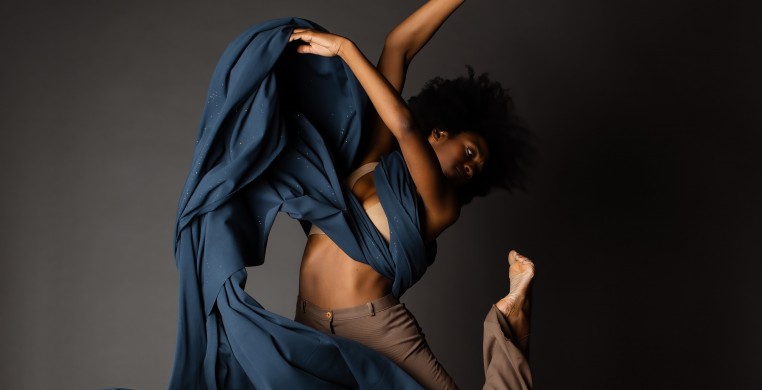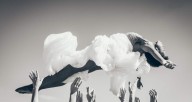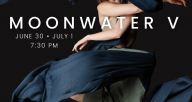Now in their fifth season, Moonwater Dance Project debuted “Moonwater V” on June 30 at the Ruth Page Center, featuring past repertoire and world premieres by Braeden Barnes, Shannon Alvis, Robyn Mineko Williams, company Executive Director, Celine Spinka O’Brien and Founder and Artistic Director, Mackenzie King.
Past performances have combined creative movement, fantastic imagery from the imagination, high levels of technical prowess and strict rhythmic acuity. Last year’s Moonwater IV set a high bar, but would the company be able to top their previous performance?
(Check out See Chicago Dance’s review of “Moonwater IV” here: Review: The Moonwater Dance Project sets the bar high in their latest presentation, “Moonwater IV")
“Cry and Fall” (2022) by Celine Spinka O’Brien abstracts the drudgery and despair of proletarian existence. An ominous horn, like a call to war, awakens a pack of mongrels who scurry and scatter, slinking low to the floor, torsos pulsing with brutal contractions of the rib cage. The sound of hissing steam from different sized pipes creates syncopated, percussion, like a funky factory in Hell; meanwhile, on their backs and with hips raised, one arm shoots straight up, fingers pinched and rolling in an unmistakable gesture—“Where’s my money!”
Then, a leader emerges, ascending, raised high on the shoulders of her peers. Like aspiring revolutionaries throughout history, she, too, becomes corrupted. Recorded voices singing in harmony ask, “How did you come to trade the fiddle for the drum?” as she crawls over the backs of her constituency, reaching for something beyond her station. No matter how hard you try, when battered by oppressive forces, sometimes all you can do is “Cry and Fall.”
Dancers Emily Brand, Lucy Pierson and Abigail Stachnik perform as a trio in Braeden Barnes’ world premiere, “Provider.” Three women wearing similar black dresses lie in a row and rise to the pang of distorted windchimes. They move like the same person living diachronically at different moments in time. Two of them, past and present versions, step back to observe the other, contemplating a future that has them rubbing their neck dolefully with their hand while prancing around on tiptoe.
The wheel of time spins forward and backwards. From locked arms they explode apart, one sliding forcefully upstage, grasping for help, crashing into each other but in reverse. In the end, all three personas converge in a huddle as timelines coalesce. Contrasting with “Cry and Fall,” which shows humans as animals, “Provider” highlights what separates us from animals, our ability to objectify our bodies and observe them at different times, the sense of hindsight and foresight affecting our decisions in real time.
“Ether,” a world premiere by Shannon Alvis, takes a “grounded” approach, turning five bodies into dry particles of dust propelled by swift gusts of wind. In kaleidoscopic patterns they twist and whirl about each other, limbs like broad brushes painting the air. Dancers in skin tone-matching unitards evolve from dirt and dust into natural structures: a tree whose roots dig deep into the earth, a winding stream, a mountain with craggy peaks. “Ether” presents nature’s circle of creation and destruction, a connected world too large and overwhelming for humanity to notice—until it’s too late!
Robyn Mineko Williams’ three excerpts from “Walk On” (2019) is a taste of something larger, feeling incomplete. Celine Spinka O’Brien performs a waltz with an invisible partner to Roy Orbison’s “The Crowd.” O’Brien is wound up by Orbison’s passionate crooning; then, slight pause, she is flung spinning, one arm loose above her head, the other wrapped around an imaginary partner. Dream becomes reality as Jade Hooper enters, bumping into her, faux-clumsily; O’Brien, surprised, slightly convulses as if hyperventilating. O’Brien leaves and Hooper remains, her mood more melancholy, less confident, and she chases her hand like an idea of happiness, never catching it. It’s obvious that there is more to the story. This touching but troubled work deserves to be shown in full.
Mackenzie King’s world premiere, “From The Ground” is an allegory for soldiers facing the horrors of war. In tight formation, a platoon marches toward the end of a cliff, their faces blank, mindlessly stepping over the threshold then falling backwards, arms trailing in front as they are pulled by gravity. Unfazed as bodies whiz past them, the others make no reaction and march on towards oblivion. Wearing dark and light brown colors, like camouflage, they melt into the inky blackness upstage, emerging from thin air in aggressive lunges, like stealthy warriors encroaching on an enemy under cover of darkness. The finale has bodies exploding into the air to the sound of radio static and dramatic violins, symbolic of simultaneous death and spiritual ascendance. “From The Ground” is the story of “those just following orders,” courageous flames that shine too briefly.
The lush imagery that these works generate is Moonwater’s greatest strength. All the allegory in this review is what comes to my imagination; certainly, other viewers will have a different sensory experience, and that’s a good thing. Compared to Moonwater IV, the work is similar in technical movement, but less acute in rhythmic execution.
To see a Moonwater show is to be an active participant. One must have the courage to follow them as they explore the fringe edges of imagination. The sense of masterful storytelling they bring to the stage will have you mulling over the meaning of each work long after the performance ends.




